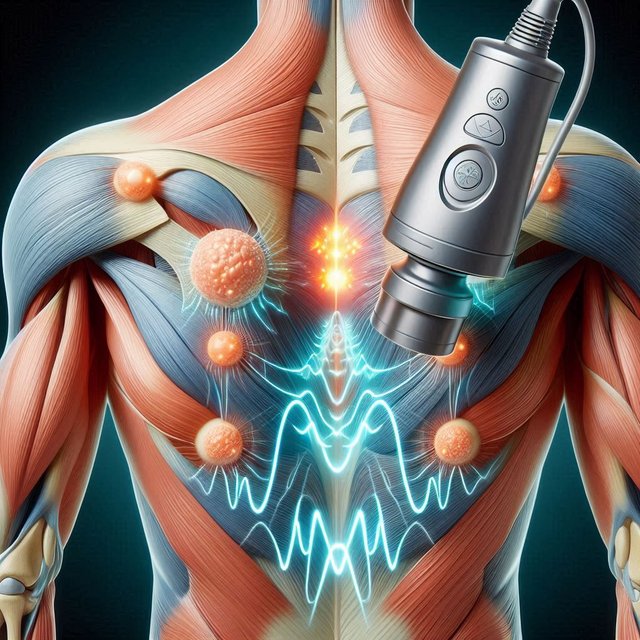Ultrasound Trigger Point Release
Pain-Free Treatment of Trigger Points
Musculoskeletal pain is one of the most common health issues affecting a large part of the population. This type of pain is often associated with myofascial trigger points, which are small, hyper-irritable nodules in the tight bands of skeletal muscles. These points are often palpable, tender, and can cause referred pain when pressure is applied. Over the past decades, there has been increasing evidence that these points play a central role in various musculoskeletal pain syndromes, and treating them is key to providing lasting pain relief.
One possible solution for addressing trigger points is ultrasound therapy. The energy from ultrasound can penetrate deeply into tissues, causing local changes that lead to pain relief. In this blog post, we will explore the effects of ultrasound on myofascial trigger points, with a special focus on the role of ultrasound cavitation on muscle tissues, fascia, and trigger points.
What is a Myofascial Trigger Point?
Myofascial trigger points are areas in skeletal muscles where hyper-irritable nodules develop within the tight bands of tissue. These points are typically tender to the touch and often cause referred pain that radiates to other parts of the body. Trigger points can form due to various factors such as poor posture, muscle overuse, stress, or muscle injuries.
The relationship between myofascial trigger points and musculoskeletal pain was first mentioned in the research of Dr. Janet Travell and Dr. David Simons. Since then, numerous studies have confirmed that trigger points play a role in chronic pain syndromes such as fibromyalgia, chronic headaches, and lower back pain. Stimulating or treating these points is crucial to alleviating pain and restoring movement functions.
The Effects of Ultrasound Trigger Point Release Therapy
Physical therapy ultrasound is widely used in treating soft tissue pain and is an excellent tool for managing myofascial trigger points. During ultrasound therapy, the device emits sound waves that create microscopic vibrations as they pass through tissues. This process increases blood flow, relaxes muscles, reduces pain, and promotes tissue regeneration.
Particularly interesting is the effect of ultrasound cavitation on muscle tissues, fascia, and trigger points. Cavitation occurs when ultrasound waves create tiny bubbles in the tissues, and the collapse of these bubbles causes micromechanical effects. This slight pressure change can help loosen the tight bands of trigger points, reducing pain and improving mobility.
The Segmental Effects of Ultrasound
An interesting study examined how ultrasound affects myofascial trigger points and segmentally connected muscles. In the study, the trigger points in the supraspinatus, infraspinatus, and gluteus muscles of 50 participants were analyzed. Ultrasound therapy was applied to the trigger point in the supraspinatus, and it was found that not only did the sensitivity of the treated point decrease, but it also resulted in significant pain relief in the segmentally connected infraspinatus muscle.
This phenomenon shows that ultrasound can trigger segmental antinociceptive effects, which act through central nervous system mechanisms. As a result of the ultrasound treatment, participants' pain thresholds significantly increased at the affected points, and this effect was observed shortly after the treatment, within 1-3 minutes.
The Effects of Ultrasound Cavitation on Muscle Tissue, Fascia, and Trigger Points
Ultrasound cavitation is a unique mechanism that penetrates deeply into muscle tissues and fascia. Fascia are connective tissue networks that envelop muscles and organs. Trigger points are often found in the fascia, and stimulating them can help relieve pain. The bubbles formed during ultrasound cavitation produce dynamic effects in the fascia, which can help eliminate tightness and muscle spasms.
Another advantage of ultrasound is that it is non-invasive and has few side effects compared to other trigger point therapy methods such as dry needling or injections. Ultrasound provides rapid and effective pain relief and is particularly useful for patients who may be apprehensive about needle treatments.
One of the key features of ultrasound trigger point release is that it is pain-free, unlike manual therapeutic interventions, which can often cause discomfort or even intense pain. The technology penetrates deep into the tissues, offering much faster and more effective relief. Patients experience minimal discomfort during and after the procedure, making it a more comfortable alternative to traditional manual methods.
Rest is Crucial After Ultrasound Treatment
It is important to note that after ultrasound treatment, rest is essential, and the treated area should not be immediately strained. Tissue regeneration takes time, so post-treatment rest is necessary for effective healing. Overloading the treated area too soon can reverse the positive effects of the treatment and increase the risk of injury or pain recurrence.
Therefore, ultrasound therapy is not only pain-free and effective, but the healing process can be smoother and faster if the rest period is properly observed.
Trigger Point Stimulation with Ultrasound
Stimulation of trigger points with ultrasound is a technique where ultrasound waves penetrate deeply into the affected tissues. The goal of the procedure is to enhance blood circulation, which helps reduce inflammation and relieve muscle tension. The micromechanical effects produced by ultrasound, such as cavitation, are particularly beneficial in relaxing muscles by effectively reducing the pain caused by trigger points.
One of the greatest advantages of ultrasound is that it works deeply without damaging the surrounding tissues. This characteristic makes it a very safe and convenient solution, especially for those suffering from chronic musculoskeletal pain. The method is not only effective but can also provide long-term relief for problematic areas with regular use.
Myofascial trigger points play a significant role in the treatment of musculoskeletal pain, and ultrasound therapy is an effective tool for reducing pain and relaxing muscles. The effects of ultrasound cavitation induce profound changes in muscle tissues and fascia, helping alleviate chronic pain. The segmental antinociceptive effects further emphasize the therapeutic importance of ultrasound, opening new possibilities for treating musculoskeletal pain. https://yangsheng.hu/ultrahangos-triggerpont-oldas/
